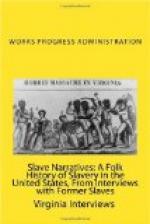During the months when there was little field work to do they were kept busy repairing fences, etc. on the farm. Every day was considered a working day except Sunday, Thanksgiving and Christmas. They were not allowed to celebrate on these days as were the slaves on other nearby plantations.
Clothing on the Ormond plantation was usually insufficient to satisfy the needs of the slave. Each year one issue was given each slave. For the men this issue consisted of 1 pair of brogan shoes, several homespun shirts, a few pairs of knitted socks, and two or three pairs of pants. The brogans were made of such hard leather until the wearers’ feet were usually blistered before the shoes were “broken in.” The women, in addition to a pair of shoes and some cotton stockings were given several homespun dresses. On one occasion Mr. Eason says that he wore his shoes out before time for an issue of clothing. It was so cold until the skin on his feet cracked, causing the blood to flow. In spite of this his master would give him no more shoes. All clothing was made on the plantation except the shoes.
Those women who were too old for field work did the sewing in addition to other duties to be described later.
Indigo was cultivated for dyeing purposes and in some instances a dye was made by boiling walnut leaves and walnut hulls in water. In addition to her duties as cook, Mr. Eason’s mother had to also weave part of the cloth. He told of how he had to sit up at night and help her and how she would “crack” him on the head for being too slow at times.
The amount of food given each slave was also inadequate as a general rule. At the end of each week they all went to a certain spot on the plantation where each was given 1 peck of meal, 1 gal. of syrup, and 3 pounds of meat. They often suffered from that particular stomach ailment commonly known as hunger. At such times raids were made on the smokehouse. This was considered as stealing by the master and the overseer but to them it was merely taking that which they had worked for. At other times they increased their food by hunting and fishing. Possums and coons were the usual game from such a hunting expedition. All meals usually consisted of grits, bacon, syrup, corn bread and vegetables. On Sundays and holidays the meals varied to the extent that they were allowed to have biscuits which they called “cake bread.” The slaves made coffee by parching corn meal, okra seed or Irish potatoes. When sufficiently parched any one of the above named would make a vile type of coffee. Syrup was used for all sweetening purposes. The produce from the gardens which the master allowed them could only be used for home consumption and under no circumstances could any of it be sold.




